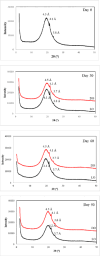Evaluation of Frying Performance, Storage Stability, and In Vitro Digestion of Extra Virgin Olive Oil-Candelilla Wax Oleogel
- PMID: 40641176
- PMCID: PMC12246661
- DOI: 10.1111/1750-3841.70405
Evaluation of Frying Performance, Storage Stability, and In Vitro Digestion of Extra Virgin Olive Oil-Candelilla Wax Oleogel
Abstract
The present study investigates the stability of an oleogel developed from extra virgin olive oil (EVOO) and candelilla wax (CDW) as a frying medium, including its 90-day storage stability under dark and light conditions and its effects on in vitro digestion. The findings of the chemical analyses indicated that the gel structure and its storage in darkness effectively reduced oxidation, whereas exposure to light accelerated oxidative degradation. In addition, the oleogel, when utilized as a frying medium, exhibited superior stability compared to EVOO. Furthermore, the oil absorption rate of sliced potatoes fried in EVOO was 14.51%, which was lower (p < 0.05) at 10.29% in potatoes fried in the oleogel. It was observed that during in vitro digestion, the gel structure reduced the interaction between lipase and oil, thereby slowing the formation rate of free fatty acids (FFA). As a result, the lipolysis rates in EVOO and the oleogel were 54% and 44%, respectively. Following in vitro digestion, α-tocopherol bio accessibility was determined to be 98% and 94% in EVOO and the oleogel, respectively, while bioavailability rates were 16% and 34%, respectively. The bio accessibility of β-carotene was found to be 53% and 41% for EVOO and the oleogel, respectively, while the bioavailability of β-carotene was 6% and 3%, respectively. These results indicate that the oleogel structured with CDW offers significant advantages in terms of storage stability and effectiveness as a frying medium. At the same time, the gel structure demonstrated a notable influence on the digestion of the components in EVOO.
Keywords: CDW; EVOO; deep‐fat frying; in vitro digestion; oleogel; oxidative stability; storage stability.
© 2025 The Author(s). Journal of Food Science published by Wiley Periodicals LLC on behalf of Institute of Food Technologists.
Conflict of interest statement
The authors declare no conflicts of interest.
Figures






Similar articles
-
Investigating the rheological properties and structure of grass pea protein isolate- sesame oil bigels for effective fat substitution in low-fat cream formulation.Food Res Int. 2025 Oct;217:116820. doi: 10.1016/j.foodres.2025.116820. Epub 2025 Jun 9. Food Res Int. 2025. PMID: 40597530
-
Characterization of improved sugarcane wax-based oleogels based on bovine bone proteins and their application as solid fat substitutes in cookies.Int J Biol Macromol. 2025 Aug;319(Pt 1):145385. doi: 10.1016/j.ijbiomac.2025.145385. Epub 2025 Jun 18. Int J Biol Macromol. 2025. PMID: 40541880
-
Enhanced Thermal Resilience of Olive Oils: Fatty Acid Dynamics with Polyphenols Supplementation.Foods. 2025 Jun 13;14(12):2085. doi: 10.3390/foods14122085. Foods. 2025. PMID: 40565694 Free PMC article.
-
Intravenous magnesium sulphate and sotalol for prevention of atrial fibrillation after coronary artery bypass surgery: a systematic review and economic evaluation.Health Technol Assess. 2008 Jun;12(28):iii-iv, ix-95. doi: 10.3310/hta12280. Health Technol Assess. 2008. PMID: 18547499
-
Ear drops for the removal of ear wax.Cochrane Database Syst Rev. 2018 Jul 25;7(7):CD012171. doi: 10.1002/14651858.CD012171.pub2. Cochrane Database Syst Rev. 2018. PMID: 30043448 Free PMC article.
References
-
- Adrah, K. , Adegoke S. C., Nowlin K., and Tahergorabi R.. 2022. “Study of Oleogel as a Frying Medium for Deep‐Fried Chicken.” Journal of Food Measurement and Characterization 16, no. 2: 1114–1123. 10.1007/s11694-021-01237-6. - DOI
-
- Ahmed, M. N. , Abourat K., Gagour J., Sakar E. H., Majourhat K., and Gharby S.. 2024. “Saffron (Crocus sativus L.) Stigmas as a Potential Natural Additive to Improve Oxidative Stability Attributes of Sunflower (Helianthus annuus L.) Oil Stored Under Different Conditions.” Grain & Oil Science and Technology 7, no. 3: 133–149. 10.1016/j.gaost.2024.06.001. - DOI
-
- Alberdi‐Cedeño, J. , Ibargoitia M. L., and Guillén M. D.. 2020. “Study of the in Vitro Digestion of Olive Oil Enriched or Not With Antioxidant Phenolic Compounds. Relationships Between Bioaccessibility of Main Components of Different Oils and Their Composition.” Antioxidants 9, no. 6: 6. 10.3390/antiox9060543. - DOI - PMC - PubMed
-
- Anonymous . 1987. Standard Methods for the Analysis of Oils, Fats, and Derivatives: 1st Supplement to 7th Edition, 1st supplement to 7th edition. Pergamon Press.
MeSH terms
Substances
Grants and funding
LinkOut - more resources
Full Text Sources
Research Materials

